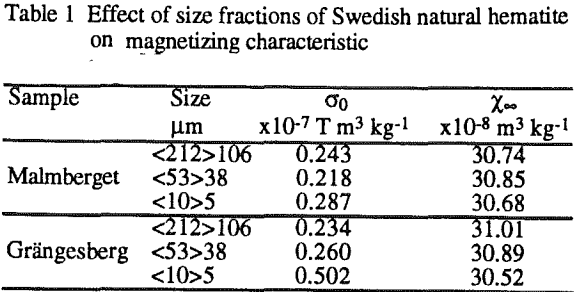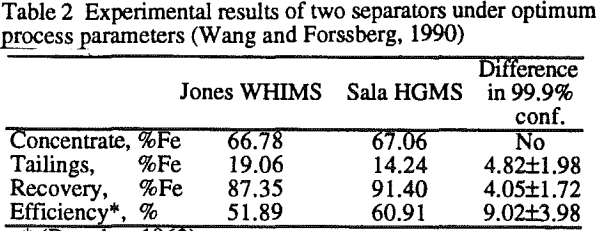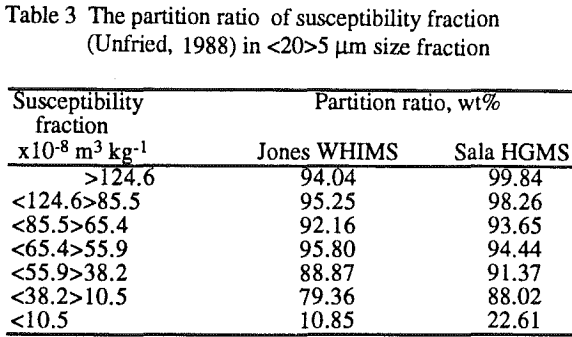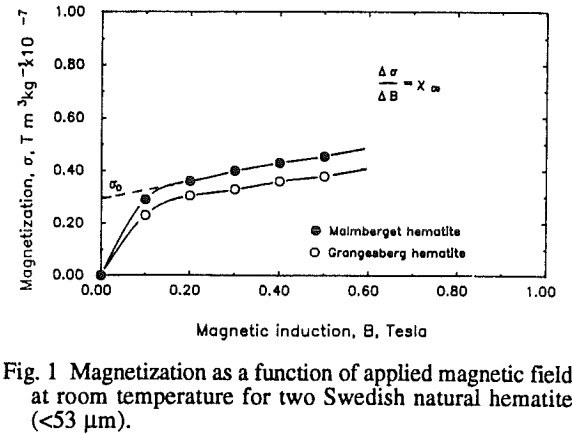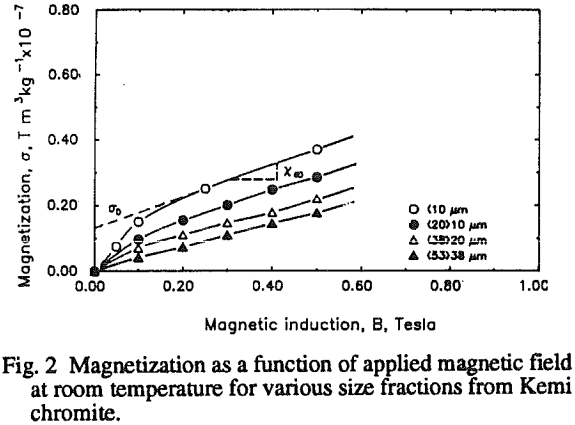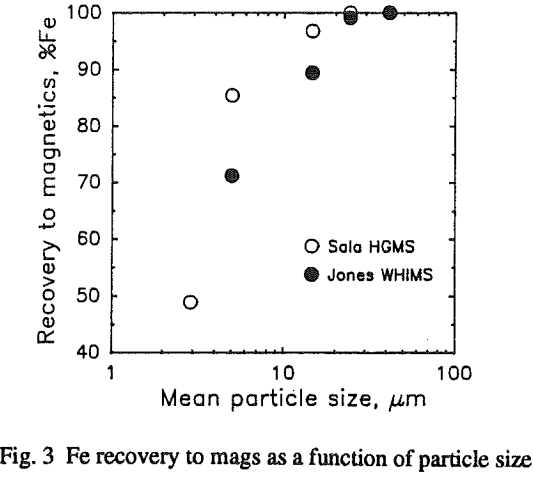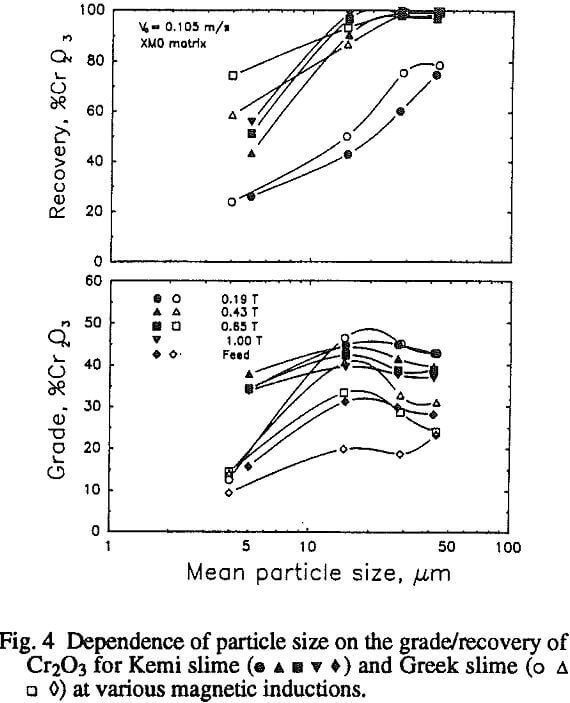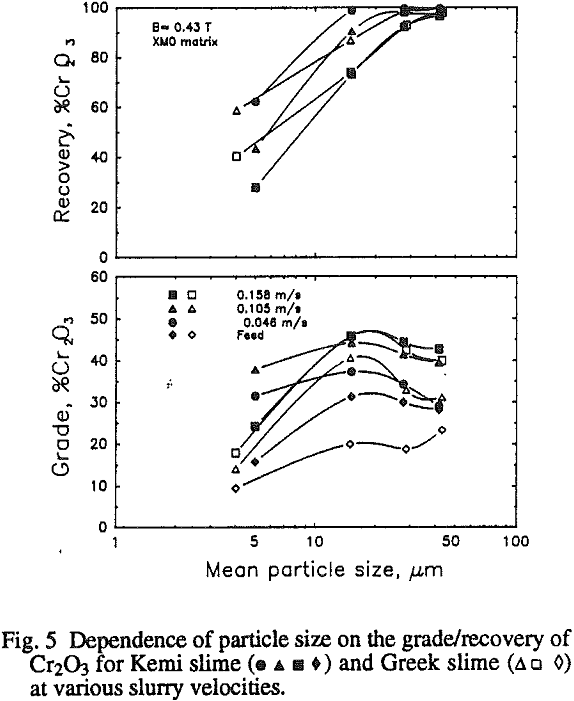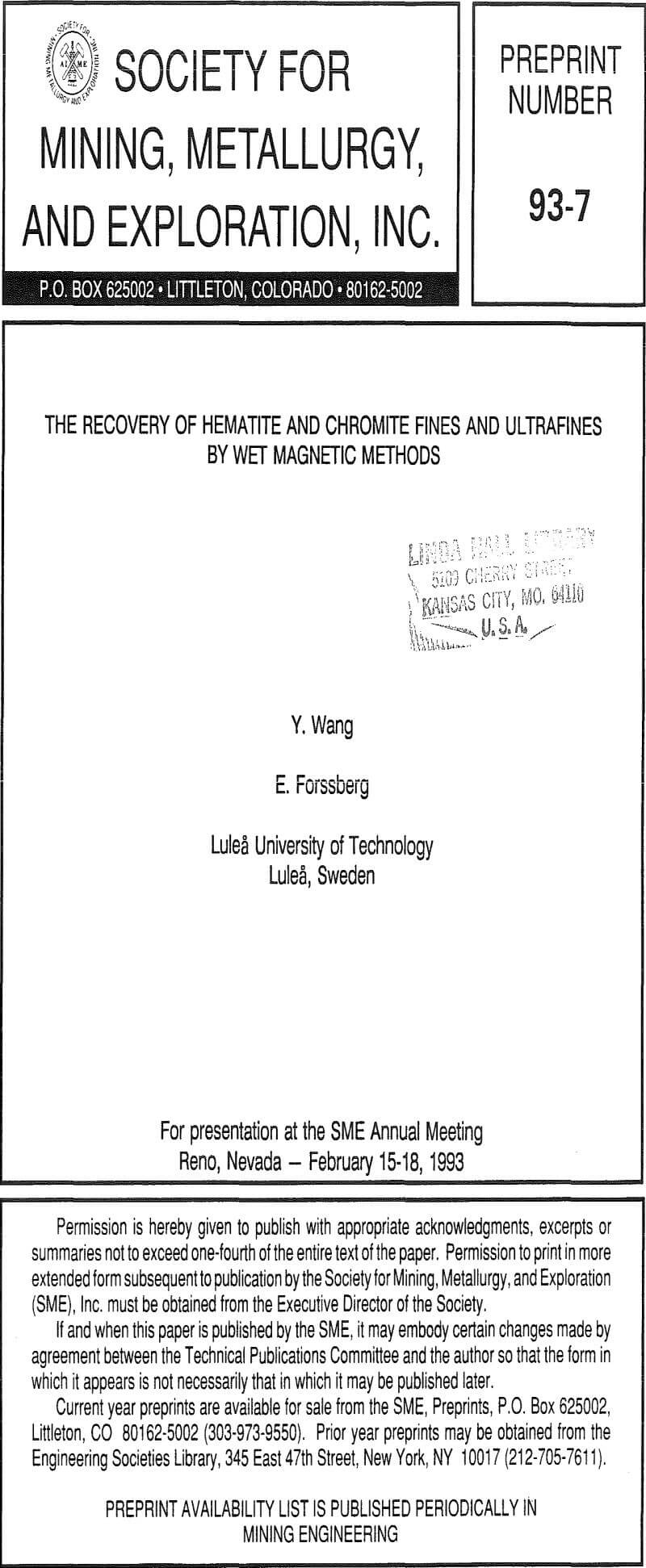Table of Contents
Wet magnetic separation methods for recovering hematite and chromite fines and ultrafines are investigated in this paper. These methods include wet high intensity and high gradient magnetic separations, carrier or “piggy-back” magnetic method, magnetic field-induced aggregation and magnetic seeding. This investigation indicates that wet magnetic separation is more efficient for fines and ultrafines whereas other methods can be used to enhance the particle aggregation and/or the magnetic response. The magnetic behaviour of these minerals with respect to magnetizing field, particle size and temperature is also presented.
Magnetic Characteristics of Natural Hematite and Chromite
The magnetic properties of natural hematite from Malmberget and Grangesberg, Sweden and a natural chromite from Kemi, Finland were investigated. These minerals would be encountered in the following magnetic separation. Magnetic measurements were carried out on these samples using a Vibrating Sample Magnetometer (VSM) and a Super-conducting Quantum Interference Device magnetometer(SQUID).
Hematite: At higher magnetic field (>0.3 T) an increase of the magnetization, σ, with increasing the applied field becomes closely linear and it can be expressed as σ=σ0+X∞ B where X∞ is a susceptibility that describes the linear behaviour at high fields, σ0 a weak ferromagnetic moment and B the magnetic induction. Correspondingly the field-dependent susceptibility, X, can be expressed as X=σ/B=σ0/B+X∞. The chemical assay on Fe²+ and the variation of temperature-dependent magnetization indicated the occurrence of ferrite with the samples. On the other hand, it is known that hematite crystals have a weak spontaneous magnetization above the transition temperature due to a departure for exact anti-parallel arrangement of the magnetic moments of the ions.
The effect of particle size on the weak ferromagnetism and antiferromagnetic susceptibility at room temperature was determined for various fractions of these samples.
Chromite: A magnetic measurement with the VSM indicated that decreasing the particle size of Kemi natural chromite increases the magnetization σ0, whereas its paramagnetic susceptibility is independent of the particle size at higher field
Wet High Intensity and High Gradient Magnetic Separations
Wet high intensity magnetic separator (WHIMS) and high gradient magnetic separator (HGMS) both are technically fine-particle entrapment devices. These separators generate, in a separation volume or zone, strong magnetic traction forces by virtue of a combination of magnetic field and field gradient. The magnetic traction force on a magnetic particle of volume, V, and of the volume susceptibility, KP , in a non-uniform magnetic field is approximately determined by
F M = (KP-Km)V Bgrad(B)
where grad( B) is the spatial gradient of the total magnetic field B at the location of the particle, and KM the susceptibility of medium.
This separator comprises an array of grooved ferromagnetic plates in the field gap of a classical dipolar C-shaped electromagnet. It was calculated that at the surface of finest grooved plates (about 2×10 -4m groove pitch) the force density is order 2×10 9 Nm³. In the grooved plate matrix, the plates are loaded in a box with the axes of the groove vertical. The HGMS device used is a Sala-HGMS 5-30-10 separator (used for other works in this paper). It is based on the insertion of ferritic matrix such as expanded metal into the working volume of high field solenoid magnet. The novel aspect of this particular design is that, if sufficiently strong magnetic fields are generated by the solenoid, then strands of this matrix, whose axes are orthogonal to the field axis of the solenoid, are magnetized radically to saturation.
For the recovery of weakly magnetic valuable minerals by HGMS, the knowledge of the separator performance as a function of particle size and of the lower size limit of the recoverable particles is important for optimization purposes and developing the process commercially. Other work emphasized only the coarse particle size (>53 µm) selectivity of a pure material using a characterized matrix. Our work was to study what happens in the more practical case of chromite ore slimes (<53 µm) with various size fractions when processed through a industrial expanded metal matrix in HGMS.
It is seen that the recovery of Cr2O3 increases with decreasing particle size. The grade of the magnetic concentrate slightly depends on the particle size. Such a dependence is due to the distribution of Cr2O3 in various sizes of the feed, it is evident that the recovery can be greatly enhanced at a magnetic induction greater than 0.43 T. However, the efficiency of capturing the particles below 10 µm cannot be further improved at high magnetic induction. On the other hand, at low velocity, the separation is non-selective, so that an increase in the recovery is negligible and the grade of the magnetic concentrate is poor; at high velocity, the selectivity improved and the concentrate of high quality can be obtained for the particles above 10 µm.
Carrier Magnetic Separation
It is well known that the relative importance of the surface, magnetic and hydrodynamic interactions depends on mineral particle size in wet magnetic separation. One variation of the magnetic separation is known as carrier or “piggy-back” magnetic separation for saving weakly magnetic valuable mineral fines and ultrafines which readily escape in industrial matrix magnetic separators.
The formation of particle aggregates prior to particle attachment to the matrix is regarded as one of the most decisive steps to improve the efficiency of a magnetic separator for slimes. Aggregate formation increases the effective particle dimensions. Therefore, the retention probability of particles on the matrix is enhanced. In homo- and hetero-aggregation, the particles in the slurry may be oppositely charged or of the same signs. Electrostatic attraction dominates in the case of particles of opposite signs. Due to the induction of higher-charged surfaces on ones of lower-charges, repulsion increases with decreasing distance but it is reversed to attraction upon further approach of the particles.
Since carrier or “piggy-back” magnetic separation uses coarse particles as carriers for finer particles, it is possible for the latter to be recovered. This technique makes use of the fact that the frequency of particle collisions is much greater when there are particles of different sizes. This is a result of different trajectories in an accelerating fluid. The rate of adhesion of fine particles (a = 2 µm) to coarse ones (a = 30 µm) is from 10³ to 10 4 as high as the rate of adhesion between fine particles.
The pH(zpc) of chromite leads to a suppression of potential barrier between the interacting particles and to an increase of the recovery of the <10 µm particles in wet magnetic separation. This may be due to two factors. Pro primo, negligible electrostatic repulsion among the particles at pH(zpc) enhances the capture rate and stability of build-up profile on the matrix.
In theory, if two colloidal minerals with different pH(zpc) values are considered, then it should be possible to improve the separation efficiency in wet magnetic separation by adjustment of the pH.
Magnetic Field-Induced Aggregation
This suppression enables the particles to aggregate into the primary minimum in the energy curve. It can be also anticipated that under certain conditions the existence of secondary minimum can lead to an aggregation of particles into this potential well. They calculated the particle trajectories leading to binary pair formation. A simulation of magnetic aggregation behaviour of mineral particles indicated the oriented chain-like aggregates form along the direction of an applied magnetic field.
According to the DLVO theory, the interaction energy between colloidal particles is expressed by the sum of repulsion terms originating from electrostatic interactions and the attractive London-van der Waals contribution. For the specific case of magnetic particles in an external magnetic field, an additive attractive magnetic interaction must be considered.
An experimental observation of magnetic field-induced aggregation for natural hematite and chromite was made by magneto-sedimentation analysis. Samples of natural hematite were obtained from Malmberget and Grtagesberg, Sweden. A natural chromite came from Kemi, Finland. The mean particle size was determined to be 3.9 µm for Malmberget hematite (97.9% Fe2O3), 3.2 µm for Grangesberg hematite (97.08% Fe2O3) and 3.6 µm for Kemi chromite (19.42%Fe; 49.59%Cr2O3), although the distribution range extended up to 20 µm for the fractions.
